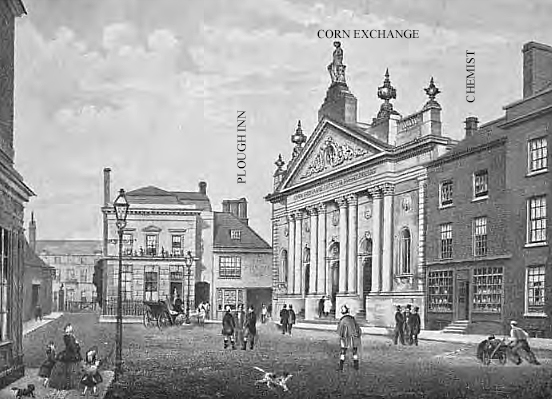Questions about Banbury and surrounding area
Questions or points of interest about Banburyshire people or places, from anyone (member or otherwise), can be sent to any Committee Member, or to the the Website; and, if they are of potential interest to members of the Society, they will be mounted here (possibly after editing). Similarly, if you have an answer, do please contact the Website
Question 30. The care of evacuees at Shutford Manor during WWII
In 1940, at the age of 5, the young Ruth Sylvia Latner was evacuated from London and housed, with two others, at Shutford Manor. Mrs Ruth Wiseman (as she now is) was very moved by the kindness of the owner (Maurice Bauer) and in particular of the housekeeper ('Elizabeth') and a housemaid ('Doreen').
She would be delighted to learn anything about the Manor House, and the subsequent lives of Elizabeth and Doreen. Perhaps there are descendents, perhaps also of the then owner Maurice Bauer Esq.
(Any information sent to the website@banburyhistoricalsociety.org will be forwarded to Ruth Wiseman.)
Question 29. Photos of Banbury Market Stall selling watches, and jewellery
"Hello!
Hope you can help me.
My dad and nana used to be on the Banbury Market, selling watches, batteries & jewellery during the 1990’s to roughly 2004. He mentioned to me the other day about wanting to see photos of himself with his mum on the market stall together, as they didn’t have any themselves. (Our shop is now in Castle Quay, Banbury Vintage Watch & Jewellery Company Limited; he’s been there for 20 years inside the centre.)
I would love to be able to find one for him. I’ve contacted Banbury Museum and they guided me to the Banbury Historical Society!
I don't know if there are any Banbury Market Photo Archives anywhere, either online or in a book which I could look through? If anyone can help, I’d be really grateful.
Many thanks, Sophie Henderson"
Answer 29.
Sophie, you could try visiting the BHS library, open Thursday afternoons (and Saturdays when manned). See https://www.banburyhistoricalsociety.org/index.php?page=library
Question 28. Regarding a photo described as "Banbury 5 Old Cottages"
Lisa is currently working on transcribing some Banbury pictures and [has] come across a picture, labelled as "Banbury 5 Old Cottages", of which they have been unable to identify the location. She wondered if any members/readers might recognise the location. (Clearly the cottages have long gone.) Please send suggestions to Website.
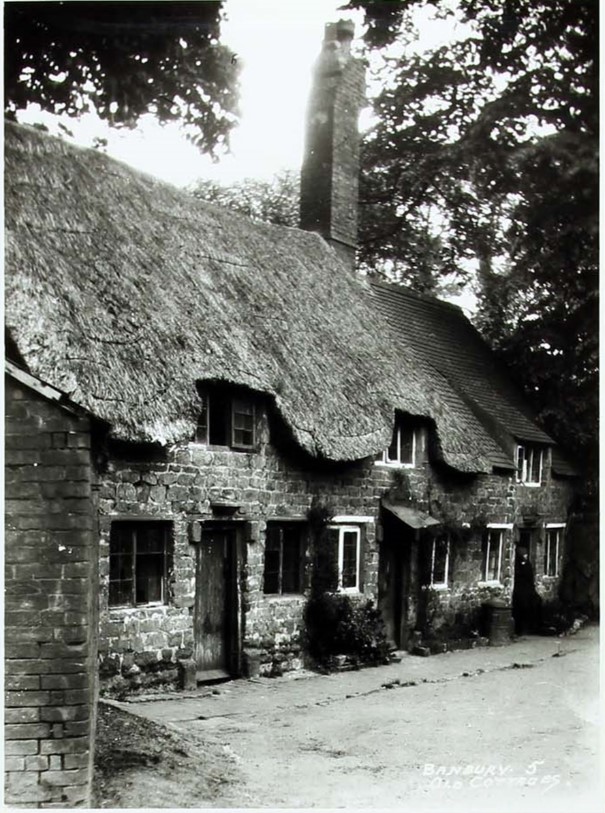
Question 27. Regarding the tall chimney stack at Banbury Station
"Would any of your members have an idea as to the original purpose of the large cylindrical chimney stack at Banbury station. I am currently working with students at Frank Wise School looking at how buildings have changed over time. The station is of great interest and the chimney stack somewhat of a puzzle.
Kindest regards." Vicki Salmon
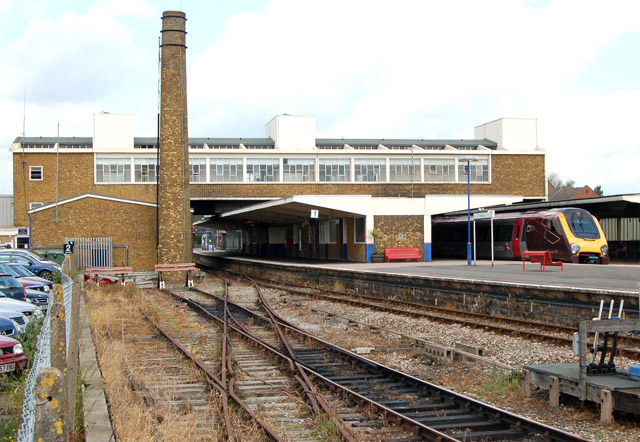
(Any information sent to website@banburyhistoricalsociety.org will be forwarded to our inquirer.)
Question 26. Some questions from Australia, about Perry's Nursery?
"I am interested in any information about the establishment, running and later closure of Perry’s Nursery located on Oxford Road, Banbury in the 1800s. Mr Peter PERRY (1836-1881) is my 2nd great grandfather with my connection being through his son, Charles Leonard PERRY who moved to Australia.
Is there any connection between Perry’s Nursery and Nursery Drive/Nursery Lane, Neithrope?
Thank you in anticipation. Yours sincerely, Alanna Cook (nee PERRY)"
(Any information sent to website@banburyhistoricalsociety.org will be forwarded to our inquirer.)
Question 25. Has anyone worked in Social Care between 1979 and 2010?

Question 24. Does anyone know how to make a Spice Ball?
Neil Iden wrote to Website as follows:
Chatting to the lady at B.I.D. this weekend, talk turned to what a 'Spice Ball' was, and whether recreating Spice Balls could be made an annual competition. However, I can find no more information than on the Town Council web-site, where it is said that a 'Spice Ball' was a pork-meat ball made (and named) by Thomas Hankinson, or alternatively a "seasoned faggot": (http://www.fraw.org.uk/blog/posts/018/index.shtml)
Does any reader have any descriptions so they could be recreated for a competition? I can not see a descriptive account of it in 'Cake & Cockhorse'. I assume they were eaten with gravy, rather than being a 'kofta' type curry. How big were they, for example?
If anyone could tell anything, and is happy to have the information passed on to B.I.D., I would be grateful. Thanks and best wishes, Neil.
(Any information sent to website@banburyhistoricalsociety.org will be forwarded to our inquirer.)
Question 23. Garage on Broad Street where the Pet Shop is now?
Was there a garage in Broad Street where Croft Pet Store is now? Who owned it and why did it disappear? Any comments appreciated.
(Any information sent to website@banburyhistoricalsociety.org will be forwarded to our inquirer.)
Question 22. The 'Victorian pleasure garden' at Woodside, Edgehill
Does anyone have any information about a garden at Woodside House, Edge Hill, as it was in the nineteenth century?
(Any information sent to website@banburyhistoricalsociety.org will be forwarded to our inquirer.)
Question 21. Memories of D-day warmly welcomed to celebrate 80th Anniversary
The amphibious invasion of Normandy by combined US and British forces under the overall charge of General Eisenhower began on 'D-Day', 6 June 1944.
The Soldiers of Oxfordshire (SOFO) Museum is doing all it can to celebrate the 80th anniversary of the D-day landings.
They are very interested to hear from people with relatives that served, particularly in Oxfordshire regiments, but also in other regiments, corps, or branches of the armed forces. Anyone with a story to share can get in touch via their website here or by using the contact details below.
https://www.sofo.org.uk/oxfordshire-d-day-stories/
Phone: 01993 810 210
Email: museumdirector@sofo.org.uk
Question 20. Information on the Easley/Casley families of Adderbury/Banbury
David Judd would appreciate hearing from anyone researching the Easley/Casley family of Adderbury/Banbury and the Rogers family from Kirtlington for the 17th century and earlier. Many thanks.
(Any information sent to website@banburyhistoricalsociety.org will be forwarded to our inquirer.)
Question 19. Memories of the old Regal/Odeon Cinema
We have been approached by Mr. Gary Donaldson who is currently writing an appreciation of the work of Mr A P Starkey, the architect of the Regal/Odeon Banbury, which was his last cinema building.
He wonders if there is anyone in Banbury Historical Society who is interested in the the building, and who might be willing to discuss it with him. In particular whether the cinema was a conversion of a former building, or if it was built on a vacant site. Gary Donaldson knows that plans were approved in 1938, but there seems to have been delays.
He is also searching for early photographs of the interior of the cinema. His article is scheduled to appear in "PICTURE HOUSE", the annual journal of the Cinema Theatre Association, under the editorship of Allen Eyles.
(Any information sent to website@banburyhistoricalsociety.org will be forwarded to our inquirer.)
Question 18. Receipts for the Purchase of Land in Grimsbury
On 6th August 1874 Henry Franklin purchased at auction a rectangular strip of land in Grimsbury, Lot 15 lying between Gibbs Road and the old Grimsbury Road (West St.?). It seems that 11 acres of farm land with planning permission for freehold accommodation was divided into 60 lots of diverse sizes but averaging 1/5 acres. Lot 15 went for £11. His great great granddaughter would love to see the original documents of purchase (deed, receipt, etc.)
Does anyone know where these might be? Perhaps the Land Registry? The sale was organised by Pellatt, Solicitor, Banbury, no longer in existence. (Any information sent to website@banburyhistoricalsociety.org will be forwarded to our inquirer.)
Question 17. Banbury Steeple Chase, 1839
Our enquirer is writing a history of old racecourses (www.mainholmpress.co.uk) and is trying to trace/buy a copy of any of the engravings of the 1839 chase. (Apparently, in 1967 the Society reproduced the one of the finish as a Christmas card.)
Does anyone know where one can get an image suitable to print, please? (Any information sent to website@banburyhistoricalsociety.org will be forwarded to our inquirer.)
Question 16. Does anyone know the origin of the name "Black Pitts Farm", as e.g. Warkworth.
"Does anyone know the meaning of the name "Black Pitts Farm", or anything about any of the Black Pitts farms of which there are many around the country, e.g. at: Warkworth, Oddington, Uttoxeter, Oldham, Cheltenham, Moreton-in-Marsh, etc.? (Is it perhaps something to do with leather tanning?)
Answer 16. Origin of placenames "Black Pitts" and "Blackgrounds", as at e.g. Warkworth. (From Deborah Hayter)
Nothing to do with leather tanning. ‘Black Pitts’ and ‘Blackgrounds’ are usually significant of Roman habitation. There were far more Romano-British settlements (mostly farmsteads or small hamlets) scattered about the local countryside than there are modern villages. Where there were early houses you get an accumulation of humus in the soil which gives a layer of ‘dark earth’ (technical archaeological term). These then got called BlackPitts or Blackgrounds as that was their distinguishing feature.
Answer 16 A comment (From Ian West)
The vegetable tanning of animal hides in pits (so-called pit-tanning) has been the standard method of making leather in Britain since Roman times. It is a lengthy and a foul-smelling process. Salted hides are soaked in pits (or pitts (sic)) of lime and water (or urine), then de-haired and de-fleshed manually on wooden stretchers. The hides are then soaked, again in pits, for several months in tanning solutions containing oak-bark (though many other vegetable sources of tannin can be used). Modern tanning methods involve trivalent aluminium or trivalent chromium sulphates to cross-link the collagen fibres. [1]
"Blackpitts [an area in Dublin] was home to tanneries, woollen mills, and weavers. One theory is that the name derives from the burial pits just outside the old city walls in which the victims of the Bubonic Plague outbreak of 1348 were buried. Another and more likely theory is that the origin is from the pits of black or brown liquids used by tanners. The area was once a hive of tanning, along with other small industries." [2]
References:
[1] https://en.wikipedia.org/wiki/Tanning_(leather)
[2] https://www.owenreilly.ie/neighbourhood/blackpitts/
(Any information sent to website@banburyhistoricalsociety.org will be forwarded to our inquirer.)
Question 15 Does anyone know when the Museum Bridge was lifted into place?
Our inquirer is writing a book about her travels on a narrowboat some 20 years ago. She remembers that, when travelling NORTH through Banbury there was no bridge, but coming SOUTH again three weeks later it was in place. But which trip? She did various trips around the millennium, from her moorings at Twyford Wharf.
(Any information sent to website@banburyhistoricalsociety.org will be forwarded to our inquirer.)
Question 14 Does anyone know who lived at 49 Oxford Rd., OX16 9AH, during the war?
(Any information sent to website@banburyhistoricalsociety.org will be forwarded to our enquirer.)
Answer 14. (Sent in by Tom Forde)
Here is some information on this question. (There must be others who have much knowledge of the Northern Aluminium/Alcan operation.)
I imagine that the specific information (names) would be hard to come by, but the Government's 1939 Register (if the street numbers were the same) records a 49A and 49B. The occupants were 6 female stenographers/shorthand typists and bookkeepers and 3 'unpaid domestic duties' - all female. They appear to work for the Northern Aluminium Company or in one case 'attached to Light Alloy Control'. So it looks as though No 49 was some kind of hostel. The details can be found on the Findmypast website.
"The Northern Aluminium Company sheet rolling factory was built to the north of Banbury in 1931, and expanded again in the mid-30s to meet increased demand from the aircraft industry. During the years of the Second World War, Banbury supplied around 60% of its needs, working in conjunction with an aluminium recycling plant near Adderbury which processed metal from crashed English and German planes. The Banbury factory employed around 4000 people at its peak, many of them women".( Sources: Brian P Cannon 2009 / Roger Hartree, Warwickshire Industrial Archaeology Society Newsletter: Number 37)...
Tom Forde
Question 13 What is the history of that land where Magenta Storage now stands?
We have an enquirer who would like to know anything at all about the land north of Hennef Way between Wildmere Road (i.e. the old Daventry Road) and the M40 motorway, i.e. where the Magenta Storage facility now stands. Grid reference 46825:41825. Farmland perhaps. And perhaps belonging to Huscote Farm? There is a will of 10 September 1663 showing that Huscote farm was lived in by Goodridge Wilson, and as it lay to the east of the Cherwell it was in Northamptonshire.This area, together with Nethercote was transferred to Bodicote parish, Oxfordshire in 1889. It lies on the flood plane of the Cherwell. Any further details would be welcomed. Contact website@banburyhistoricalsociety.org
In the old Ordnance Survey 1" of 1949, there is (of course) no motorway, and no housing, as Old Grimsbury did not cross the old Daventry road (B4036). A good place to go for maps online is http://www.banburyshiremaps.co.uk/banbury1833.htm.
Question 12 Banbury Bank (alias Gillett and Tawney Bank)
Martin Thompson writes: I wonder if any of your members can help me please? Two images extracted from "Cake & Cockhorse" show Cornhill in c. 1857, before and after the construction of the Corn Exchange. (Annotated copies are attached below.) The caption of the one showing the Corn Exchange Facade says that Banbury Bank is "next to the Plough Inn and the Corn Exchange". However I cannot see a building that lies between these two. Can anyone identify the Bank on either (or both) images, please? Is it perhaps the building to the left of the Plough (as we look at it)? Thank you.
(Please contact the website@banburyhistoricalsociety.org or Martin Thompson direct)
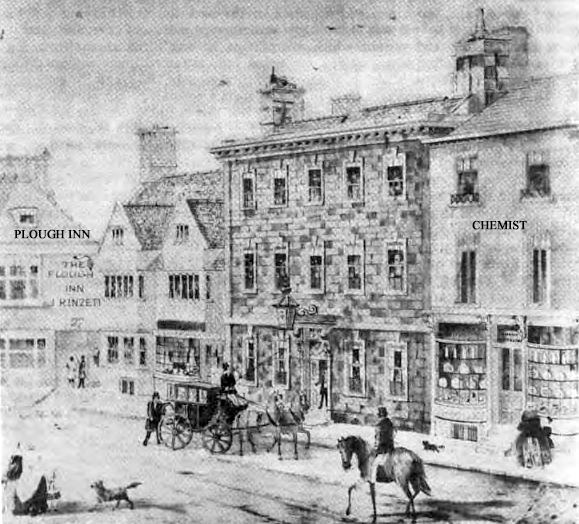
Answer 12 (from Ian Dufour)
I have a pamphlet* titled “200 Banking Years in Banbury” published by Barclays in 1984. It includes a photograph of the original Cornhill premises (at the time of the photograph it was St John Ambulance Brigade) and it is indeed the building to the left of the Plough as postulated by Mr Thompson. According to the text it started as a bank in 1784 under the title "Bignell, Heydon and Wyatt” and changed hands twice in 1819/20, later becoming Gillett’s until 1919 when it was purchased and administered by Barclays. I am unsure of the title “Banbury Bank” as the pamphlet is unclear on that. There is however a picture of a banknote from 1857 in the name of “Banbury Bank” and another of “some of the last Gillett cheques dated 1896 - the year of the amalgamation with Barclays” which is inconsistent with the text! The latter picture is attributed to the Banbury Museum. The Tawney connection mentioned in the title to Q12 seems to be the brief interim transfer in 1819/20. I could send a scanned copy of the pamphlet if it would help Mr Thompson. (* A copy has been sent to the Society Library, Dec 2022.)
My own recollection (probably imperfect) is that it was still known (and possibly branded) as Gillett’s when I opened an account at it in the late 1950’s being re-branded as pure Barclays some time later. My recollection is also that it was then in High St., somewhere between the junction with Marlborough Rd. and George St. on that side (but it is well over 50 years since I lived in Banbury). The main Barclays was then near the Town Hall (Bridge St./Broad St. corner?) and long before a branch opened in Horsefair. It has probably all changed since.
Regards, Ian Dufour (now in Suffolk)
(Martin Thompson has just brought out a book dealing with his Tawney ancestors: "TAWNEY of Oxford: and their Relatives" by Martin K Thompson (Author); Paperback – 2 Nov. 2022; available from Amazon.)
Question 11 Turton and Luckett, Electrical Engineers
The painted metal sign ( see below) suggests the existence of a firm of Electrical Engineers call Turton & Luckett operating in Banbury in the first few decades of the 20th century with the telephone number Banbury 154. If anyone knows anything about the firm, or the names “Turton" or “Luckett", the owner of the painted metal sign would be very grateful to hear. (Please contact the website@banburyhistoricalsociety.org )
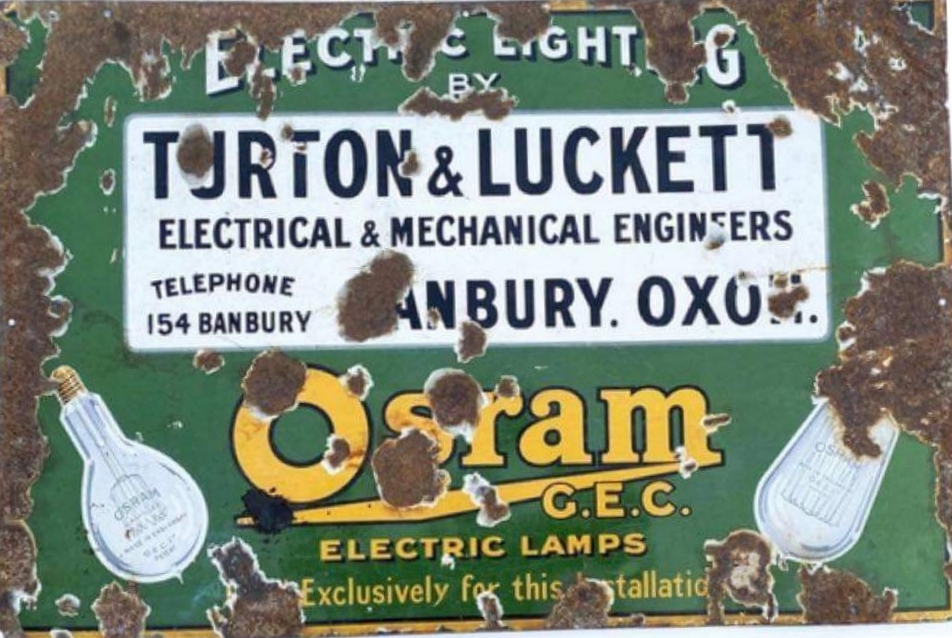
Question 10 (Any photographs of Heyford Station? Or info on Simon Foote?)
The Secretary of 'Friends of Heyford Station' (Bruce Eggeling, +44 (0) 1869 34 99 50) has asked if anyone has any photos of Heyford Station before it was demolished. Likewise, if anyone knows a Mr. Simon Foote. He writes:
"Recently we have discovered that the old station building at Heyford was dismantled and stored, in pieces, back in the 1980s. The station is now being recreated at Didcot Railway Centre. You can read about the project here: http://gwsheyford.org.uk/.
"We are very keen to find any photos that anyone may have of the inside of the main station building. Also some years back there was a talk and show from a man called Simon Foote who had sound film of Heyford station taken in the early 60s and several very evocative photos of the inside of Heyford signal box. If anyone is able to throw any light on Simon Foote or has any photos or other information about the old station we would be very pleased to be informed."
(Any emails concerning this sent to website@banburyhistoricalsociety.org will be forwarded.)
++++++++++++++++
Question 9 (Unwanted copies of old BHS Records Volumes)
George Hughes wonders if anyone has unwanted copies of old and 'out-of-print' volumes of the Banbury Historical Society Records series. In particular Records Volume 13 (1591-1620) and Records Volume 14 1621-1650) Wills and Inventories by Brinkworth & Gibson. He would be very pleased to hear from you (davidgeorge.hughes@outlook.com).
(Any emails concerning this sent to website@banburyhistoricalsociety.org will be forwarded.)
++++++++++++++++
Question 8 (Grey Court House, Astrop)
We have a request from an historian in Chile who is interested in any aspects of the life of Chilean artist José Tomás Errázuriz (1856-1927), who seems to have owned Grey Court house, in Astrop, King's Sutton, near 1920 (probably 1918-1922). If anyone has any information on Errázuriz, or on Grey Court House, Astrop, Doctora Soléne Bergot would be pleased to hear it.
(Any emails concerning this sent to website@banburyhistoricalsociety.org will be forwarded.)
++++++++++++++++
Question 7 (Family history)
Gill Borrington of Brackley is keen to find out more about her mother-in-law – Birdie Diana Cheer, born close to 7th May 1917 in Warwick Road, Banbury, possibly at (or near) 87 Warwick Rd..
(Any emails concerning this sent to website@banburyhistoricalsociety.org will be forwarded.)
++++++++++++++++
Question 6 (Gardens and gardeners)
Elizabeth Taylor, who is a member of the Northamptonshire Gardens Trust, is researching Charlton Lodge gardens and gardeners particularly in the period 1830 - 1945. She wonders if any BHS members or readers of the BHS website have any information; perhaps the names of head or assistant gardeners. Documents or photos would be particularly welcome.
(Any emails concerning this sent to website@banburyhistoricalsociety.org will be forwarded.)
Question 5 (directed primarily at Railway Historians)
Robin Simmonds is preparing a paper for a Welsh Railway magazine, on the arrangements made to convey Oxfordshire iron ore to Baldwins’ new blast furnaces at Port Talbot, the first of which was 'blown-in' in 1922. He has a reasonably complete account of the connections and services the GWR provided to transport the Wroxton ore to South Wales, but not for the Brymbo Steel Co.’s. kilns at Council Hill Sidings, Hook Norton. He writes:
"What I am really looking for are the GWR Appendices to the Working Time Tables for this location. The GWR included the Banbury & Cheltenham Railway in its West Midland Section which covered Oxford, Worcester & Stourbridge Junction. Confusingly, this was Section No. 14 pre-1922, but changed to No. 15 thereafter. I possess a copy of the Appendix for Section No. 15 dated April 1950. I am aware that an Appendix for Section No. 14 was issued dated March 1914, although I have not seen one yet. So, I am hoping to be directed to the March 1914 Appendix and/or one issued between 1914 and 1950."
(Any information to website@banburyhistoricalsociety.org will be passed on.)
++++++++++++++++
Question 4
Sue Jarvis would be pleased to hear any information or suggestions anyone might have concerning a Mr. F. Mulley who lived at Boxhedge House (1914 - 1923), Calthorpe Manor House (1923), and Little Bourton House (1953). He traded as a Human Hair Merchant, the firm becoming “Banbury Postiche”. She is hoping to find photos of any of the workers, or the buildings from the past 100 years."
(Replies to website@banburyhistoricalsociety.org will be forwarded.)
++++++++++++++++
Question 3.
Louise Price writes: "I am interested in the history and development of the Bretch Hill Housing Estate of Banbury and schools in the area. Does anyone know of any research, planning documents, books, journals or websites which may be helpful?
Kind regards, Louise Price (9th Oct. 2020)"
(Any suggestions sent to website@banburyhistoricalsociety.org will be passed on)
Website writes: When compiling the new Archive of the Cake & Cockhorse journals I noticed a number of articles mentioned the Bretch Hill Estate. You could browse the archive on the BHS website, but I suggest you go to the 'Search' page, and type in 'Bretch Hill'. The first 20 results are all to 'house number 90' where one of our editors used to live. But there are many more references following that. Or you could try 'Bretch Hill Housing Estate'.
Question 2.
Frederick Simson is doing some genealogical research on his 'Weaver' and 'Simson' ancestors who lived in Kings Sutton in the 19th century (though by 1920 his immediate relatives had moved to London). From the census returns from 1841-1911 he has learned that during that period Weavers and Simsons lived in various houses in Whittall Street, namely: Nos. 22, 24, 136, 137, 145 & 160. He is puzzled that present day Whittall Street only runs to No. 30. Were house with higher numbers pulled down, or was Whittall longer in the past, running northeast into Richmond St. or south towards Mill Lane? Or was it somewhere else altogether?
He writes: "My question is: was there a different Whittall Street, not only with more dwellings in the street but possibly of a more modest type of accommodation? For the present houses are substantial and look as though they have been there for many years and do not lead one to believe that they have ever been given over to multi occupancy. The Francis Frith photos of Whittall Street taken around the turn of the century indicate that it had indeed been previously known as the 'High Street' but there is no indication as to when this name change had taken place."
Website received helpful comments from Tom Forde of Kings Sutton, as follows:
"There is only one Whittall Street in Kings Sutton, running north from Astrop Road to the junction of Bulls Lane and Richmond Street. Old large scale Ordnance Survey maps of Kings Sutton can be viewed on the admirable National Library of Scotland website. They show a much larger number of small dwellings than exist today, and some of these may have been occupied by more than one household.
What the Census schedule lists is each separate household and not the different houses. Indeed, in the 1851 form (for example) the extreme left hand column is headed 'No. of householder's schedule'. It lists the households in each street or other location (but does not indicate whether they share a building). The form does ask for a house number but in many places this requirement was not fulfilled. In the 1871 census house numbers were not recorded in Kings Sutton, however by 1891 they were, with Nos 1 to 28 in Whittall Street. The enumerators did their work when they could find the occupiers at home and so, in the 1851 schedule, entries for Whittall Street can be found at Refs 19-38 and again at 128-145 (as Whittle Street!). John Simson, a Baptist minister, was at Ref 24 and William Weaver, a wheelwright, was at Ref 130."
(Any suggestions sent to website@banburyhistoricalsociety.org will be passed on)
Question 1.
Dear whom it may concern.
I am making enquiries about the history of Wykham Park and Sir Arthur Smith-Bingham, in possible relation to my late father who was born 1916 in Dorden near Tamworth and went to Polesworth school. In his class was a Arthur Bingham. They both left (and parted company) at the mandatory age of 14 in 1930. From what my father told me in the past, possibly a year from leaving school he went into “ gentlemens service” for a Sir Arthur Smith -Bingham who had previously lived near Polesworth and had moved to Banbury area, and his son was the Arthur Bingham who had been in my fathers class. My father worked his way up and very shortly became a First Footman Valet. On his day or evenings off he and fellow servants /workers used to frequent The Three Pigeons public house. He also mentioned that when Sir and Lady Bingham went to a show in London he accompanied them with their chauffer. I have a few “sepia” photographs of my father's which I believe to be of Wykham Park manor and some of the servants ( including my father) relaxing in the grounds, obviously on their time off. I am hoping that all of the above can be confirmed with what knowledge you may have already about Wykham Park. I read one of your past “Cake and Cockhorse” journals which mentions that Sir Smith-Bingham owned Wykham from 1928-1939. I am hoping that this is one and the same. I can if you wish look out these photographs and scan one or two of them and email them to whoever may want to have a look to confirm if my photo’s are indeed Wykham Park.
Regards, Anthony Archer.
Webmanager writes: There is a brief mention of Smith-Bingham in the Victoria County History Oxfordshire; Vol 10 Banbury Hundred (available online):- "Robert William Perks, later M.P. for Louth (Lincs.) and President of the Wesleyan Conference, purchased Wickham Park from (x) in 1903, and was still there in 1915. (ref. 147) Later occupants were Major Eric Crossley (1920, 1928), and Arthur Turberville Smith-Bingham (1939). (ref. 148) In 1969 Wickham Park was a girl's public school, Tudor Hall School." . There is reference online to an Arthur Turberville Smith-Bingham (1906-1988), who got married to Jean Garland in 1930 whose son Charles Arthur Smith-Bingham was born 1931; but no evidence so far of where he lived or of a title.


